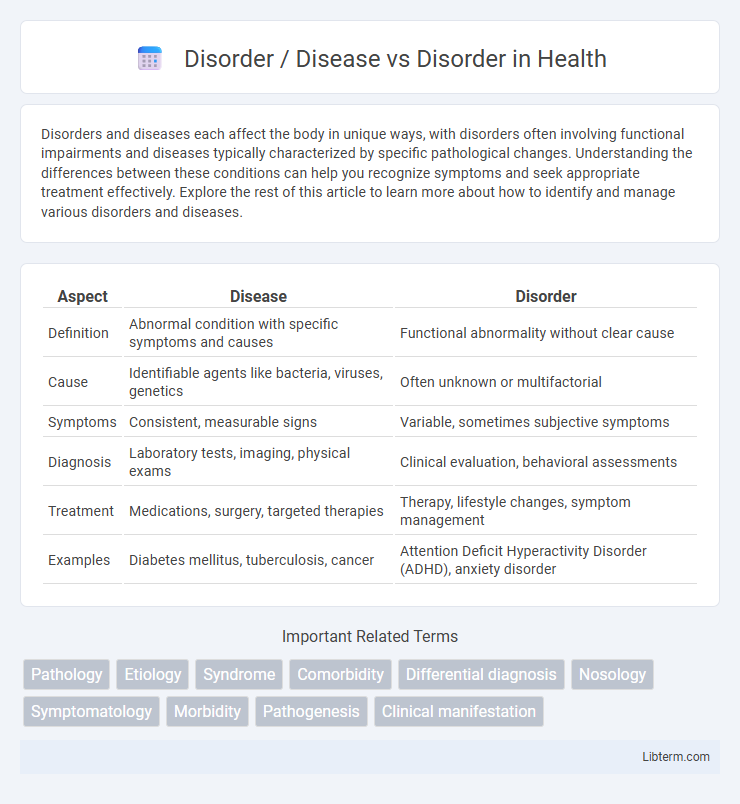Disorders and diseases each affect the body in unique ways, with disorders often involving functional impairments and diseases typically characterized by specific pathological changes. Understanding the differences between these conditions can help you recognize symptoms and seek appropriate treatment effectively. Explore the rest of this article to learn more about how to identify and manage various disorders and diseases.
Table of Comparison
| Aspect | Disease | Disorder |
|---|---|---|
| Definition | Abnormal condition with specific symptoms and causes | Functional abnormality without clear cause |
| Cause | Identifiable agents like bacteria, viruses, genetics | Often unknown or multifactorial |
| Symptoms | Consistent, measurable signs | Variable, sometimes subjective symptoms |
| Diagnosis | Laboratory tests, imaging, physical exams | Clinical evaluation, behavioral assessments |
| Treatment | Medications, surgery, targeted therapies | Therapy, lifestyle changes, symptom management |
| Examples | Diabetes mellitus, tuberculosis, cancer | Attention Deficit Hyperactivity Disorder (ADHD), anxiety disorder |
Understanding Disorders: Definitions and Classifications
Disorders encompass a broad range of health conditions that disrupt normal functioning, while diseases typically refer to specific pathological processes with identifiable causes and symptoms. Understanding disorders involves examining their definitions and classifications based on symptoms, etiology, and impact on bodily systems. This semantic distinction supports accurate diagnosis, treatment planning, and epidemiological research within medical and psychological fields.
Defining Disease: Clinical Perspectives
Disease refers to a pathological condition characterized by specific signs, symptoms, and consistent anatomical or physiological abnormalities identifiable through clinical evaluation and diagnostic testing. Disorders, while sometimes overlapping with diseases, are often defined as functional abnormalities or disturbances that may not always have clear structural or biochemical markers. Clinical perspectives emphasize that diseases typically have identifiable etiologies and predictable courses, whereas disorders may represent a broader category including syndromes and functional impairments without definitive pathological findings.
Key Differences Between Diseases and Disorders
Diseases typically have identifiable causes such as pathogens, genetic mutations, or environmental factors, whereas disorders often refer to functional abnormalities without a clear etiology. Diseases usually present with specific, recognizable symptoms and clinical patterns, while disorders may manifest as a range of symptoms affecting mental, physical, or biochemical functions. Treatment approaches for diseases often target the root cause, whereas managing disorders frequently involves symptom relief and improving quality of life.
Etiology: Causes of Diseases vs. Disorders
Diseases typically have identifiable etiologies such as infections, genetic mutations, or environmental factors, allowing for targeted diagnosis and treatment strategies. Disorders often arise from complex interactions between genetic predispositions, neurochemical imbalances, or psychosocial stressors, making their causes less clear-cut. Understanding the distinct etiological bases of diseases and disorders aids in developing precise interventions and improving patient outcomes.
How Symptoms Vary: Disease vs. Disorder
Symptoms of diseases often follow a predictable pattern linked to specific pathological causes, facilitating diagnosis through identifiable signs such as inflammation, infection, or organ dysfunction. Disorders, however, typically present with a broader, more variable range of symptoms that may fluctuate in intensity or coexist with psychological or behavioral components, complicating their clinical identification. Understanding the symptom variability between diseases and disorders is crucial for accurate diagnosis, treatment planning, and patient management.
Diagnosis: Distinguishing Between Disorder and Disease
Diagnosis of disease typically relies on objective, measurable criteria such as lab tests, imaging, and biomarkers that confirm structural or functional abnormalities. Disorders, however, may be diagnosed primarily through clinical evaluation of symptoms and behavioral patterns without definitive laboratory evidence. Distinguishing between disorder and disease facilitates targeted treatment strategies and informs prognosis based on the underlying etiology and pathological findings.
Treatment Approaches: Managing Disease vs. Disorder
Treatment approaches for diseases typically involve standardized medical protocols targeting identifiable pathogens or physiological abnormalities, such as antibiotics for bacterial infections or chemotherapy for cancer. In contrast, managing disorders, especially mental or developmental disorders, often requires multidisciplinary strategies combining psychotherapy, behavioral interventions, and lifestyle modifications to address complex symptoms and improve quality of life. Personalized treatment plans and ongoing monitoring are critical in both cases to optimize outcomes and adapt therapies based on patient response.
Impact on Daily Life: Functional Differences
Disorders and diseases both affect daily life but differ in functional impact; diseases often involve identifiable biological causes and physiological disruptions, leading to more acute or chronic symptoms that directly impair physical health. Disorders, while sometimes linked to diseases, primarily involve psychological or behavioral dysfunctions that influence cognitive processes, emotional regulation, or social interactions, affecting daily functioning in subtle or complex ways. Understanding these distinctions guides tailored interventions to improve quality of life and manage specific impairments effectively.
Medical and Social Stigma: Disease vs. Disorder
Disorders are often perceived as less severe and more manageable conditions compared to diseases, which are typically associated with identifiable pathophysiological causes, leading to differing levels of medical and social stigma. Diseases generally attract more empathy and structured treatment frameworks, while disorders, especially mental or developmental ones, frequently face misunderstanding and social marginalization. This distinction influences healthcare approaches, insurance coverage, and societal attitudes, impacting patient outcomes and quality of life.
Future Directions in Disorder and Disease Research
Future directions in disorder and disease research emphasize precision medicine approaches to tailor treatments based on genetic, environmental, and lifestyle factors. Advances in AI-driven diagnostics and biomarker identification enhance early detection and personalized intervention strategies. Cross-disciplinary collaborations and big data analytics accelerate the understanding of complex pathophysiological mechanisms underlying chronic disorders and diseases.
Disorder / Disease Infographic

 libterm.com
libterm.com